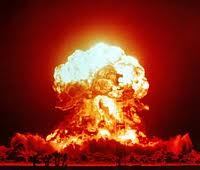The term “downwinders” refers to people, either individually or in communities, who have been exposed to radioactive materials as a result of nuclear fuel mining, nuclear weapons production and testing, nuclear waste disposal or nuclear accidents. The term derives from the fact that people who are downwind of an event that expels radioactive particles and gases into the atmosphere will be exposed to the fallout when the particles move through the air and fall to the ground. The common use of the term now includes radioactive contamination of ground water and the food chain as well as the atmosphere.
Increased appearance of cancers, non-cancerous thyroid disease and congenital malformations have been documented in many communities that have been exposed to radioactive contamination from diverse sources. The Linear No-Threshold Model is used to estimated the exposure of individuals to radioactive contamination based on the amount of radiation and the length of exposure. Other demographic factors also have an impact on the way that radiation exposure affects the health of a particular community.
Since 1945, there have been an estimated 2,000 nuclear devices exploded worldwide. The United States alone has exploded over 1,000 nuclear bombs. Up to 1980, there were about 500 atmospheric nuclear tests conducted by the U.S, U.S.S.R. U.K., France and China with the U.S. accounting for over 300. Most of the U.S. tests took place in Nevada or the Pacific Proving Grounds in the Marshall Islands. However, tests have also been conducted in Alaska, Colorado, Mississippi and New Mexico.
Nuclear explosions create the famous “mushroom cloud”. After the cloud reaches it maximum height, it begins to move downwind. Churning in the cloud spreads radioactive particles and gases throughout. Larger particles tend to settle near the site of the explosion while smaller particles and gases can be distributed across the world by the jet stream. Some clouds even reach the stratosphere and their radioactive materials may remain there for years until they finally fall to the ground. While downwinder refers to someone near a nuclear event, in a very real sense, everyone in the world is downwind of nuclear fallout.
Early in the Nuclear Age, the main concern about health risks of radioactive exposure centered on the fear that radiation would cause genetic damage and result in birth defects in the children of the people exposed. Subsequently it was found that the major risk was not genetic damage but damage to the health of the exposed people. Cancers that develop over the years following exposure are the main problem but there are also other types of tissue damage and illnesses resulting from radiation exposure.
In 1963, many nuclear nations and other nations who did not yet have nuclear weapons signed the Limited Test Ban Treaty pledging to not test nuclear bombs in the atmosphere, underwater and in outer space.. The Soviet Union stopped testing in 1990, the U.K. stopped in 1991, the U.S. conducted its last underground test in 1992 and France and China stopped testing in 1996. North Korea tested a nuclear device in 2009. In 1996, the United States and several other nuclear powers drew up the Comprehensive Test Ban Treaty (CTBT) in 1996. The Treaty will come into effect after all signatory countries file ratification documentation with the United Nations. To date, the United. States Congress has not ratified the CTBT.
